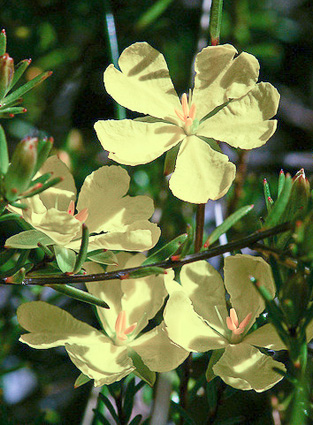Flower of the Hibbertia rufa group (Photo by Ian Sutton) |
Have you ever tried searching for a species by its scientific name on an online data portal and not found it? Chances are its full scientific name has been misspelt – but more likely that different variations of the name had been recorded in different datasets. Commonly, if data users do not list all possible combinations for a taxon when searching, the search results will be incomplete and the researcher will have to spend considerable time ‘second guessing’ likely different versions to search.
To improve searching for researchers in the Australian Ecological Knowledge and Observation System (ÆKOS), the Eco-informatics facility has added a taxonomy search capability in the portal. It covers plants, and will eventually include animals. One of the experts involved in the project is Eco-informatics data analyst Mr Andrew Graham.
‘Just about all searches on databases struggle with returning results for different versions of the same scientific name because of the different types of classification systems adopted by researchers,’ Andrew says. ‘The divergence is often due to differences in opinion, for instance where authorities endorse different species concepts or use different conventions for citation. Even where national standards such as the Australian Soil and Land Survey Field Handbook are adopted in principal, different observers often modify the classification to suit their needs.’
A good example of the ‘scientific name search’ challenge can be shown with the genus Hibbertia (of the family Dilleniaceae). Its classification was recently revised: seven new species, a new combination and four new subspecies from the subgenus Hemistemma were published in the scientific Journal of Adelaide Botanical Gardens. The H. rufa species group from the central coast region of New South Wales has been split into four species. Unless databases are updated regularly to include new revisions, it can be difficult for researchers to reconcile old and new information in databases. Curation of this kind requires substantial resources, and although data managers endeavour to do this it still remains a challenge for researchers.
The main benefit of ÆKOS’s taxonomy-search capability is that it allows all datasets to be searched on a common classification while maintaining accurate details of the taxonomy as they were entered into the source dataset. The search capability adds significant functionality to the ÆKOS repository as it allows different sources to be aligned against a set of national taxonomic standards, called the National Species Lists (NSL), which include the Australian Plant Names Index and the Australian Plant Census. The lists, which were developed as part of the Atlas of Living Australia project, form the core of the scheme ÆKOS has adopted for integrating taxonomies.
There are five step in taxon matching in ÆKOS.
- Scientific names from different datasets are checked to establish their format, and broken into constituent parts (genus, species, epithet, author). This determines whether names are published or not, and whether they are qualified by author or underspecified, for example Hibbertia species
- The named parts are matched against the NSL (addressing spelling and format variations) to establish whether the taxon is already listed in ÆKOS.
- Names that do not match the list are added to a local concept list and linked to any existing taxonomic parents.
- Taxa and any related synonyms drawn from ÆKOS are used to tag observations so these can be retrieved using any version of the name.
- Users can then search for differing species names from local or NSL lists to locate records across many datasets that contain the supplied names or synonyms.
Dr Jeff Foulkes, the Coordinator of TERN AusPlots, said many ecologists would value this improvement in ‘scientific name searching’ at the national level. ‘It can be frustrating when you know that certain species exist in particular datasets from across the country, but it’s extremely difficult and time consuming to combine them because data collectors or data systems use different taxonomic classification systems. Species taxonomy evolves with new information and to assist research it is imperative that researchers, data managers and databases such ÆKOS update their information to ensure that species can always be found.’
Data stored in ÆKOS will be updated using both automatic and manual data transfer at intervals agreed with the data custodians. Stay tuned for more about ÆKOS’s data transfer software.
For more information, contact Eco-informatics’s Ecological Information Manager Dr David Turner on (08) 8313 1191.

Diagrammatic representation of how taxonomic data is verified, matched and made available for researchers |
Published in the TERN e-Newsletter October 2012.







